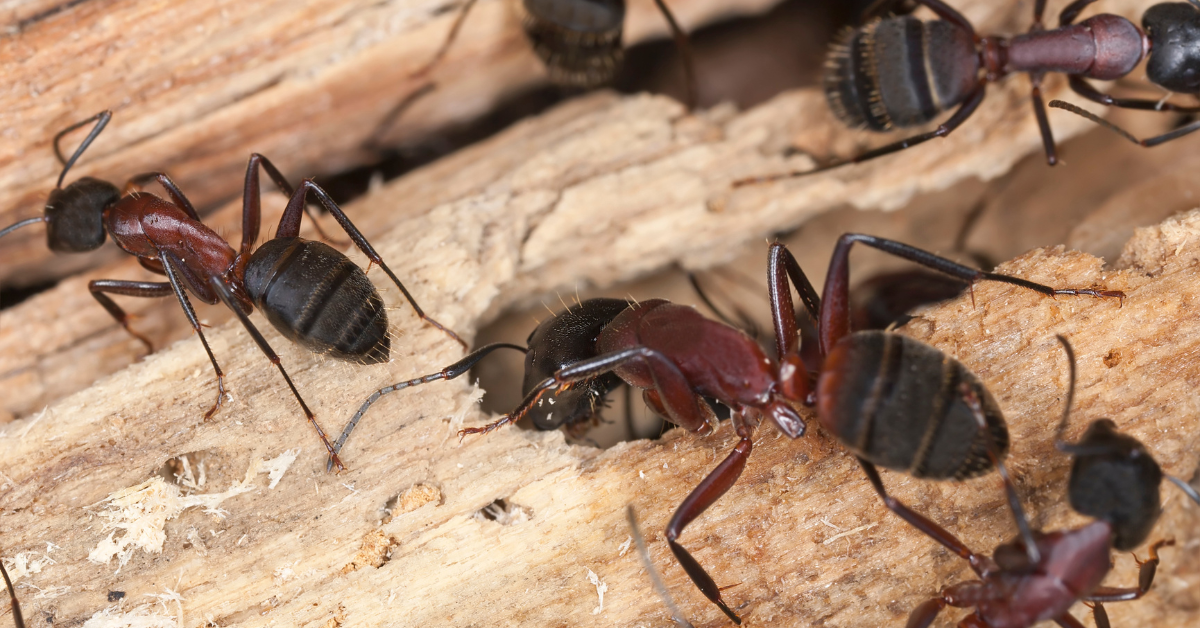Carpenter ants can cause big trouble. They chew wood and damage your home. Don’t worry! There are simple ways to stop them. This guide will help you learn how to kill carpenter ants the easy way. Anyone can do it, even if you’ve never dealt with ants before. Let’s get started and fix the problem fast.
Signs of a Carpenter Ant Infestation
Hollow Sounds in Wood
Knock on your walls or wooden furniture. If it sounds hollow, carpenter ants might be inside. They make tunnels as they build nests, removing the inner part of wood.
Wood Shavings Near Entry Points
Carpenter ants push out debris as they dig. This looks like tiny sawdust or sand piles. You’ll often see it near window sills or baseboards. If you notice these signs, start treating the area quickly to avoid bigger issues.
How to Kill Carpenter Ants Effectively
Find and Destroy the Colony
Killing visible ants won’t solve the problem. You need to locate the colony, especially the queen. Use bait or follow their trail to find where they live.
Use Insecticidal Dusts and Gels
Once you find the nest, inject dust or gel bait into the holes. These products kill slowly, giving time for ants to spread poison inside the colony. Over a few days, the queen and the workers die off.
Natural Remedies to Kill Carpenter Ants
Vinegar Spray Solution
Mix vinegar with water and spray around entry points and trails. It won’t kill them but disrupts their scent trails. They can’t find their way back and may move out.
Diatomaceous Earth and Borax
Food-grade diatomaceous earth cuts their bodies and dries them out. Borax, when mixed with sugar, attracts ants and poisons them slowly. Both are cheap and pet-safe.
DIY Carpenter Ant Baits That Work
Sugar and Borax Ant Trap
Combine sugar and borax with water and place it in small lids near ant trails. Ants love sugar, so they eat it and take it back to the nest. This helps kill them at the source.
Peanut Butter and Baking Soda Trick
Mix equal parts of peanut butter and baking soda. Place small amounts near nest areas. The ants eat the mixture and die from internal reactions. It’s safe around kids and pets.
Best Commercial Products to Eliminate Carpenter Ants
Top-Rated Ant Killers
Terro Liquid Bait and Advion Gel are very popular. They come pre-loaded and are easy to use. Ants feed on it and return to the colony, spreading the poison.
Safe Spray and Dust Formulas
Use sprays with bifenthrin or permethrin around entry points. Ant dust works well inside wall voids. Always follow safety instructions on the packaging.
How to Kill Carpenter Ants in Walls and Ceilings
Drilling to Access Nests
If you hear ants inside walls, drill small holes and puff in insecticidal dust. This reaches deep inside where the queen hides. Plug the holes afterward with filler.
Using Listening Devices
At night, use a flashlight and listen for faint crackling sounds in walls. Carpenter ants are most active in the dark, which helps you locate the nest easier.
Outdoor Carpenter Ant Control Tips
Inspect Trees and Logs
Check for ants crawling up tree trunks or wooden fences. Dead trees or damp logs are common nesting sites. Treat them with ant dust or bait to stop the spread.
Seal Exterior Gaps and Cracks
Ants sneak in through tiny cracks. Use silicone caulk or foam sealant to block entry points near doors, pipes, and vents. This keeps new ants from entering.
Carpenter Ants vs Termites: Know the Difference
Physical Differences
Carpenter ants have narrow waists and bent antennae. Termites look chunky with straight antennae. Ants also have elbowed legs and longer back wings.
Type of Damage
Termites eat wood, but carpenter ants only dig through it. Both can cause major damage over time, so quick action is necessary for either pest.
How to Prevent Carpenter Ants from Returning
Fix Moisture Problems
Carpenter ants love damp wood. Repair any leaks in your roof, plumbing, or around windows. Use a dehumidifier in moist areas like basements.
Regular Cleaning and Inspections
Keep your home tidy. Don’t leave food out and sweep up crumbs. Store food in airtight containers. Check for signs of ants once a month.
How Professionals Kill Carpenter Ants
Use of High-Grade Insecticides
Exterminators use stronger chemicals than over-the-counter products. These reach deeper into walls and wood. The treatment is more thorough and faster.
Whole-Home Treatment Plan
Professionals inspect the whole house. They find satellite nests and create a custom plan to treat all areas. This ensures complete removal and prevents re-entry.
Are Carpenter Ants Dangerous to Humans or Pets?
Do They Bite?
Yes, but not often. Their bite can pinch but isn’t poisonous. It’s more annoying than harmful. However, infestations are dangerous to your home’s structure.
Pet-Safe Solutions
Use non-toxic options like diatomaceous earth or homemade baits if you have pets. These are effective and don’t pose a risk to animals.
Seasonal Tips to Deal with Carpenter Ants
Spring Swarming Season
Spring is when winged carpenter ants fly out to mate. If you see them indoors, you likely have a nest inside. Act fast to stop it from spreading.
Winter Indoor Activity
In winter, they stay active inside heated homes. Don’t ignore ants just because it’s cold. Continue baiting and inspecting year-round.
How to Find a Carpenter Ant Nest
Follow the Ant Trails
Use honey or sweet syrup to attract ants. Watch where they go. This will help you trace the trail back to their nest location.
Nighttime is Best
Ants are more active at night. Use a flashlight to spot their movement. This helps you know where to place baits or sprays for maximum effect.
How to Kill Carpenter Ants Without Toxic Chemicals
Boiling Water Method
If the nest is in the yard, pour boiling water directly into it. The heat kills ants on contact. Repeat a few times for full results.
Soap and Water Spray
Mix dish soap and water in a spray bottle. Spray it directly on ants. It kills by suffocating them and is safe to use around pets and kids.
You May Also Like: Golden State Warriors vs Portland Trail Blazers Match Player Stats & Game Breakdown
Conclusion
Carpenter ants don’t have to stay in your home. You can get rid of them with a few smart steps. Just follow the methods in this guide. Keep your space clean, seal up holes, and use safe tricks to kill them. Now you know how to kill carpenter ants and protect your home for good.
FAQs: How to Kill Carpenter Ants
Q1: Can carpenter ants destroy my home?
Yes. They can weaken wooden structures and cause expensive damage.
Q2: Are carpenter ants harmful to humans?
Not really. They may bite, but it’s not dangerous or poisonous.
Q3: What kills carpenter ants instantly?
Sprays with bifenthrin work fast. Soapy water can also kill on contact.
Q4: How do I find their nest?
Follow their trail with sweet bait or look for wood shavings.
Q5: Do natural remedies really work?
Yes, especially borax and vinegar if used consistently.
Q6: Should I use bait or spray?
Use bait to target the nest and spray for quick kills.
Q7: What attracts carpenter ants?
Damp wood, sweets, and greasy food attract them indoors.
Q8: Can I kill them without chemicals?
Yes. Use boiling water, diatomaceous earth, or soap sprays.
Q9: How long to remove an infestation?
It can take days to weeks depending on the size and method.
Q10: Will they come back after treatment?
Yes, if you don’t fix moisture problems and seal your home.

Evelyn White is an experienced content writer with a background in lifestyle, trends, and practical advice. With several years of writing across digital platforms, she specializes in making everyday topics accessible, informative, and engaging. Her goal is to deliver trustworthy, reader-focused content that’s both useful and easy to understand.
Discover more from Try Hard Guides
Subscribe to get the latest posts sent to your email.

